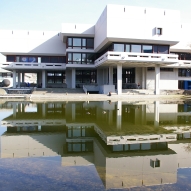| PDF (347kB) - Nur für Mitarbeiter des Archivs |
- DOI zum Zitieren dieses Dokuments:
- 10.5283/epub.15108
Alternative Links zum Volltext:DOI
Zusammenfassung
The reactions of 2-borane-1,3,4,5-tetramethylimidazoline (BH3·NHCMe) with selected phosphane adducts of the Lewis acids B(C6F5)3 and Ga(C6F5)3 are studied. Among others, adducts (C6F5)3Ga·PH2Cp* (1a) and (C6F5)3B·PH2Cp* (2) are used as starting materials. When the (C6F5)3Ga-phosphane adducts 1a and (C6F5)3Ga·PPhH2 are treated with BH3·NHCMe, the Lewis acid/base stabilised phosphanylboranes ...

Nur für Besitzer und Autoren: Kontrollseite des Eintrags



 Downloadstatistik
Downloadstatistik